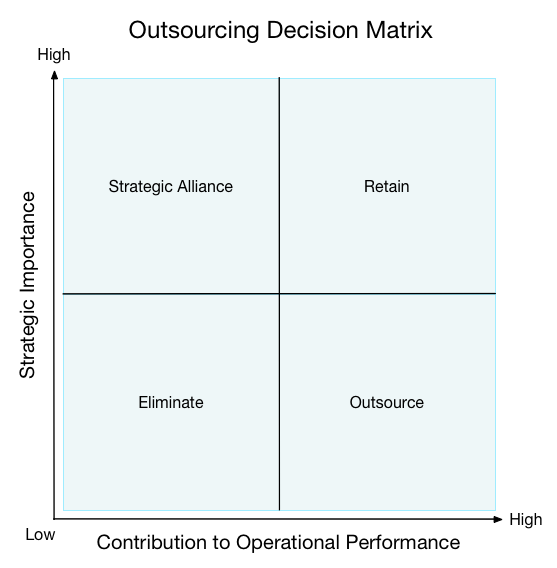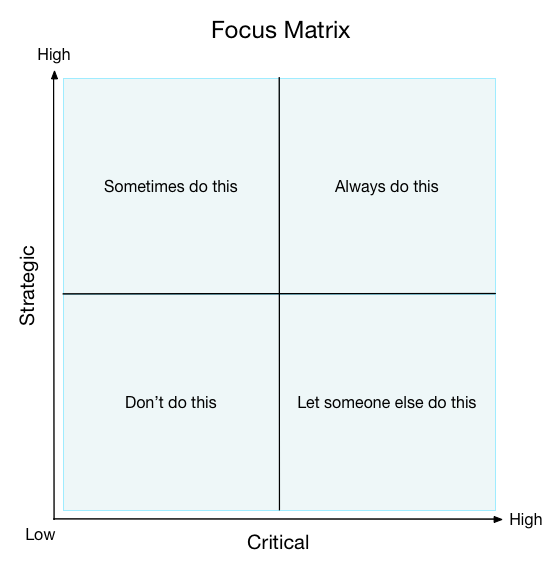How to Focus: The Startup Focus Matrix

In this article I want to talk about a model of thinking that I think a lot of successful companies follow. From startups to enterprises, either explicitly or without knowing it, they do this.
Because I’m in the startup world and that’s the world I know, that’s what I’ll focus this article on. Though I do believe it will be useful for non-startup companies as well.
Everyone knows that the number one thing a startup needs is focus, everyone keeps spouting that advice, focus. But what should we focus on? While some excellent articles, like Paul Grahams “Startup Growth”, describe a model of thinking well. When it gets down to practice it can actually still be confusing when you’re met with the various realities of running a business. This is further complicated when you’ve found market fit and can sustain a profitable business, I.E. you’ve moved from startup to small business.
Though the immediate cause of death in a startup tends to be running out of money, the underlying cause is usually lack of focus.
– Paul Graham
The 80s and 90s were flush with matrix and quadrant analysis in
business
modelling. One such Matrix is the Outsourcing Decision Matrix, which seems fairly
commonly known. In this article I will present the Outsourcing Decision Matrix and then talk
about how I think it can be applied more generally and ultimately help you focus on what’s
important.
Outsourcing Decision Matrix
The Outsourcing Decision Matrix is a model for how to make the decision whether to keep some particular aspect of your business in-house or outsource it to someone else. I can’t find who coined this idea but the earliest writings I can find around it are from the early 90s, so this isn’t a new concept. It is typically drawn up as follows.

If something contributes a great deal to operational performance of the business, and it’s of little strategic importance, essentially meaning that it’s not what sets you apart from your competitors, then you should outsource it. When people reference this model they are typically talking about outsourcing development work, IT resources or other “major” decisions like that. I argue that you can apply this model to even the smallest decisions within your company.
Lets rephrase!
If we remove some of the business jargon and rephrase/simplify the above we get the following matrix. Then I think it’s pretty clear how we can apply this to general decision-making in a company.

Lets first define the axes a little bit. Strategic means “Strategic value” or “Differentiation”. What is it that defines your business? If you’re a hotel-booking service then the hotel-booking experience is highly strategic. Maybe getting the most hotels is strategic. Maybe your twist is luxury hotels, then getting the most expensive hotels on your site is strategic. Things like where you host your hotel-booking service or what type of call-center software you have isn’t strategic. Critical means how important it is for your business to have something to be able to operate. While hosting isn’t strategic, it is critical, you don’t want to have downtime on your service.
Strategic — Critical
Something that is both strategic and critical is what is the core of your business. If there’s something that needs to be done here, you should focus on it. Make sure that whatever you have in this quadrant is of the highest possible quality.
Non-strategic — Critical
This square is interesting, in the outsourcing decision matrix this is what you should outsource. The same goes here. But by outsourcing I don’t mean that you should let someone else write the code for this piece and you still own it. Hand it over completely to someone else! This is fortunately easy today. Thanks to the wealth of “X as a Service” businesses out there, you can find almost any non-strategic software or service out there, already built, polished and ready for use. You just have to pay for it, and you should.
If you need a piece of software for, for instance, handling support emails. You could build a rudimentary version of that yourself in a couple of weeks, Email handling is pretty easy after-all right? But you shouldn’t, the moment you start building something yourself you start discovering how hard something is and how many details there are to think about. As soon as you build something yourself you now have that technical debt and overhead, you need to maintain it, wake up if it’s crashing etc. Remember, Code is a liability, not an asset!
If you could pay $1000/mo to make all that pain go away, obviously you should, it will let you focus on Strategic — Critical things!
Non-strategic — Non-critical
This section should be a no-brainer, but I see businesses dealing with things here surprisingly often. I think the origin of items in this quadrant is that people start a project or an idea thinking that it will be strategic, but it ends up not being so. Instead of then killing the idea they want to make some use of the time and money spent on it so they keep it alive. It’s dangerous to keep items in this quadrant alive because it will detract from your focus of strategic items. You need to cut your losses and get rid of things in this quadrant as soon as possible.
Strategic — Non-critical
This is the most difficult quadrant to make decisions in to be honest. In a startup, you’re lucky if you’ve found a Strategic — Critical item to work on. Here you’ll spend your time on what you think is strategic. Because it’s not fully developed yet or because it might not even be in the market yet, it can’t be critical. This is why shipping early is so important, it lets you determine whether something is critical and should move to the Strategic — Critical quadrant. You will build almost everything in the Strategic — Non-critical quadrant on assumptions. You have to test those assumptions as quickly as possible and move it to the top-right or bottom-left quadrant (and kill it).
If you ever see something living in this quadrant for long, you need to find out whether it’s worth keeping around at all. If it is, perhaps you should consider outsourcing it through partnerships or buying the service from someone else SaaS-style.
Err on the side of outsourcing!
As a die-hard developer who wants to do everything himself, this goes against my nature in many ways, but you should always err on the side of outsourcing too many things! Again, I don’t mean that you should hire a bunch of consultants or an outsourcing firm to build your thing. I mean, if there’s a SaaS that provides some service that you’re planning on building yourself, buy that service instead. If it proves that this service can’t do what you want it to do, ask them to expand their service to fit your needs. If after that they can’t fit your needs and you can find no-one else to offer you a service that fits your need, you may need to build this in-house. Another way to express this idea is to avoid the “not invented here syndrome.”
It can be hard to place projects and pieces of a service into the correct quadrants in this matrix. Even if we correctly place them, as in the Strategic — Non-critical quadrant, it can be hard to determine what to do with the item. I still hope that this way of thinking will help you be a bit more ruthless about what you should be or should not be doing.
The main benefit of working in a startup is that you can move quickly. Moving quickly is of no use if you’re only moving quickly to rebuild what others already provide.